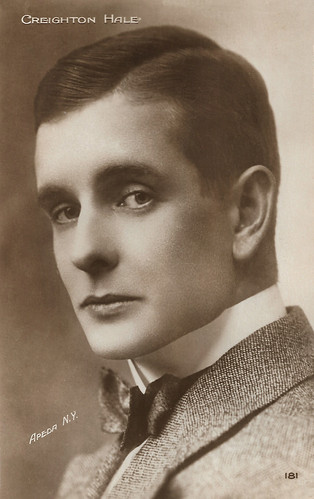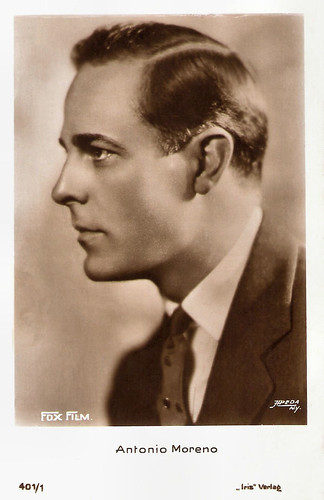
British postcard by Vandyck printers, Bristol/London. Photo: Apeda, New York.
Pearl White (1889-1938) was dubbed 'Queen of the Serials", and noted for doing her own stunts, in silent film serials such as The Perils of Pauline (1914) and The Exploits of Elaine (1914-1915). Many episodes ended with a literal cliffhanger. In Europe, The Exploits of Elaine was re-edited with two subsequent serials into Les Mystères de New York. Until the end of the First World War White remained globally a popular action heroine.

Swedish postcard by Förlag Nordisk Konst, Stockholm, no. 659. Photo by Apeda (Alexander W. Dreyfoos) / Triangle Film.
Dorothy Dalton (1893-1972) was an American actress on the silent screen, at Kay-Bee, Thomas Ince Corp, and Famous Players/ Paramount. In the early 1920s, she was a huge film star.

Swedish postcard by Förlag Nordisk Konst, Stockholm, no. 867. Photo: Apeda N.Y. / Triangle-Keystone Films.
Mabel Normand (1892-1930) was a popular American silent film comedienne, in particular in her films with Charlie Chaplin. But alcohol, drugs, and scandal wrecked her career and TBC killed her at a young age.

Swedish postcard by Förlag Nordisk Konst, Stockholm, no. 923. Photo: Apeda / Skandinavisk Film-Central, Stockholm.
Mary Pickford (1892-1979) was a legendary silent film actress who was known as 'America’s Sweetheart.' She was a founder of United Artists and helped establish the Academy.

British postcard in the 'Pictures' Portrait Gallery, London. Photo: Apeda.
Mary Pickford (1892-1979) was a legendary silent film actress who was known as 'America’s Sweetheart.' She founded United Artists and helped establish the Academy.
A landmark copyright case
The Apeda Studio was in business in New York City from 1906 to 1990. With its industrial developers and mechanised postcard printers, the Apeda Studio was an immediate success. Like many studios servicing the theatrical community, Apeda, and its staff of photographers sold prints to the general public of their sitters. They also bought up the negatives of their competitors and made copies of photographs distributed by other photo studios, going so far as to remove other studio logos and replace them with the Apeda mark.
In 1912 Apeda began selling copies of White Studio's production stills for The Chorus Lady, A Gentleman of Leisure, Gentleman from Mississippi, and Thais under the Apeda name. In 1913, Apeda won the ensuing lawsuit, White Studio v. Dreyfoos, in a landmark copyright case. The decision rested on the court's understanding of work for hire. If an actor hired White Studio to produce a portrait, there was nothing prohibiting him from going to Apeda to reproduce that image in hundreds of copies at a lower cost than White would charge, since the actor himself holds the portrait copyright.
Like Underwood & Underwood, Apeda would buy up the entire production archive of photographers who had business difficulties or were moving to other parts of the country. Apeda, for instance, bought up the negatives of the Geisler-Andrews firm after the partners split. In the 1920s, Obstfeld surrendered the business management to Harold Danziger, whose background was in theatre management. Dreyfoos remained head photographer, lensing sittings himself, and overseeing a small staff of event photographers and college yearbook portraitists.
The several photographers who contracted for work with Apeda over the years were conversant in every contemporary portrait style, often imitating signal features of high-profile photographers of the day. If there was any discernible ability characteristic of the company's photography, it was the ability to portray the whole body of the subject. Apeda's photo of Bert Errol in drag was featured on a postcard. It also published a photograph of minstrel performers in blackface. While whole-body portraiture was normal in sports and dance photography, it grew infrequent in 1920s theatrical portraiture, with whole-body shots being associated with production stills. Apeda photographers bucked the trend, producing whole-body non-production portraiture after it went out of fashion in Manhattan.
During the mid-1930s and 1940s, Apeda left off performing arts work, turning to advertising imagery, industrial photography, high school class portraiture, and Armed Services portraiture. In the later 20th century, it was reorganized as Apco Apeda and operated until the 1990s when its New York headquarters encountered difficulties with the Environmental Protection Agency for chemical pollution. The International Center of Photography (ICP) and Library of Congress have collections of photographs from the studio.

British postcard in the Cinema Chat series. Photo: Apeda / Famous Players.
Pauline Frederick (1883-1938) was an American theatre and film actress. Frederick made a name for herself in the theatre and had already passed thirty when she became successful in Hollywood. In the period of silent pictures, she was one of the most powerful actresses in the film industry.

British postcard in the Cinema Chat series. Photo: Apeda / Paramount.
Enid Bennett (1893–1969) was an Australian silent film actress, mostly active in American film. She peaked in the late 1910s and early 1920s with films such as Robin Hood (1922), starring Douglas Fairbanks. In 1931 she played Jackie Coogan's mother in the Oscar-winning film Skippy. She was the wife of director Fred Niblo and after his death, director Sidney Franklin.

French postcard by Editions Cinémagazine, no. 39. Photo: Apeda.
Thomas Meighan (1879-1936) was an American stage and screen actor, noted for his films with directors William and Cecil B. DeMille.

French postcard by Editions Cinémagazine, Paris, no. 181. Photo Apeda, New York.
Creighton Hale (1882–1965) was an Irish-American stage, screen, and TV actor, whose career spanned more than half a century, from the early 1900s to the end of the 1950s. From 1914, Hale worked at Pathé, having his breakthrough with the serial The Exploits of Elaine (1914), followed by the subsequent Pathé serials The New Exploits of Elaine, The Romance of Elaine, and The Iron Claw. He also provided comic sidenotes to D.W. Griffith's prestigious dramas Way Down East (1920) and Orphans of the Storm (1921), while he was Florence Vidor's unlucky suitor in the comedy The Marriage Circle (Ernst Lubitsch, 1924), the comic hero in the horror comedy The Cat and the Canary (Paul Leni, 1927), and the male lead in Benjamin Christensen's Seven Footprints to Satan (1929), released both as silent film and part-talkie.

French postcard by Editions Cinémagazine, Paris, no. 186. Photo: Apeda.
May McAvoy (1899-1984) was an American actress on the silent screen, best known as Esther in Ben-Hur (Fred Niblo, 1925).

German postcard by Ross-Verlag, no. 844/1, 1925-1926. Photo: Apeda (Alexander W. Dreyfoos), New York / British-American-Films A.G. Bafag.
American actress Lillian Gish (1893-1993) was 'The First Lady of the Silent Screen'. During the 1910s, she was one of director D.W. Griffith's greatest stars. She appeared in features such as The Birth of a Nation (1915); Broken Blossoms (1919); and Orphans of the Storm (1921). After 13 years with Griffith, she moved to MGM where her first picture was La bohème (1926). In the 1940s she again appeared in a handful of films and received a Best Supporting Actress Oscar nomination for her role as Laura Belle McCanles in Duel in the Sun (1946). Her last film was The Whales of August (1987) in which she shared the lead with Bette Davis.

German postcard by Ross Verlag, Berlin, no. 1275/1, 1927-1928. Photo: Apeda, N.Y. (Alexander W. Dreyfoos).
Russian prima ballerina Tamara Karsavina (1885-1978) was renowned for her beauty. She was a principal artist of the Imperial Russian Ballet and later of the Ballets Russes of Sergei Diaghilev. She also appeared in a few silent films. After settling in Britain at Hampstead in London, she began teaching ballet professionally and became recognised as one of the founders of modern British ballet. She assisted in the establishment of The Royal Ballet and was a founder member of the Royal Academy of Dance, which is now the world's largest dance-teaching organisation.

Austrian postcard by Iris Verlag, no. 401/1. Photo: Apeda (Alexander W. Dreyfoos), New York / Fox Film.
Antonio 'Tony' Moreno (1887-1967) was a Spanish-born American actor and film director of the silent film era and through the 1950s. In his early films, Moreno was often typecast as the 'Latin Lover'.

Spanish postcard by Ediciones Adolfo Zerkowitz, no. C-52. Photo: Apeda. Collection: Marlene Pilaete.
Gertrude Olmsted (1897-1975) never quite reached the first rank of Hollywood silent film stars. Nevertheless, she was in high demand in the 1920s and was featured in about sixty films. After ten years of intense activity, she decided it was time to retire and enjoy a happy married life.

French postcard. Photo: Metro-Goldwyn / Photo by Apeda (Alexander W. Dreyfoos), New York.
William 'Billy' Haines (1900–1973) was an American film actor and interior designer. By the end of the silent era, he was regularly named as the No. 1 male box-office draw of Hollywood.
Sources: David S. Shields (Broadway Photographs), The New Found Photography, and Wikipedia.
No comments:
Post a Comment